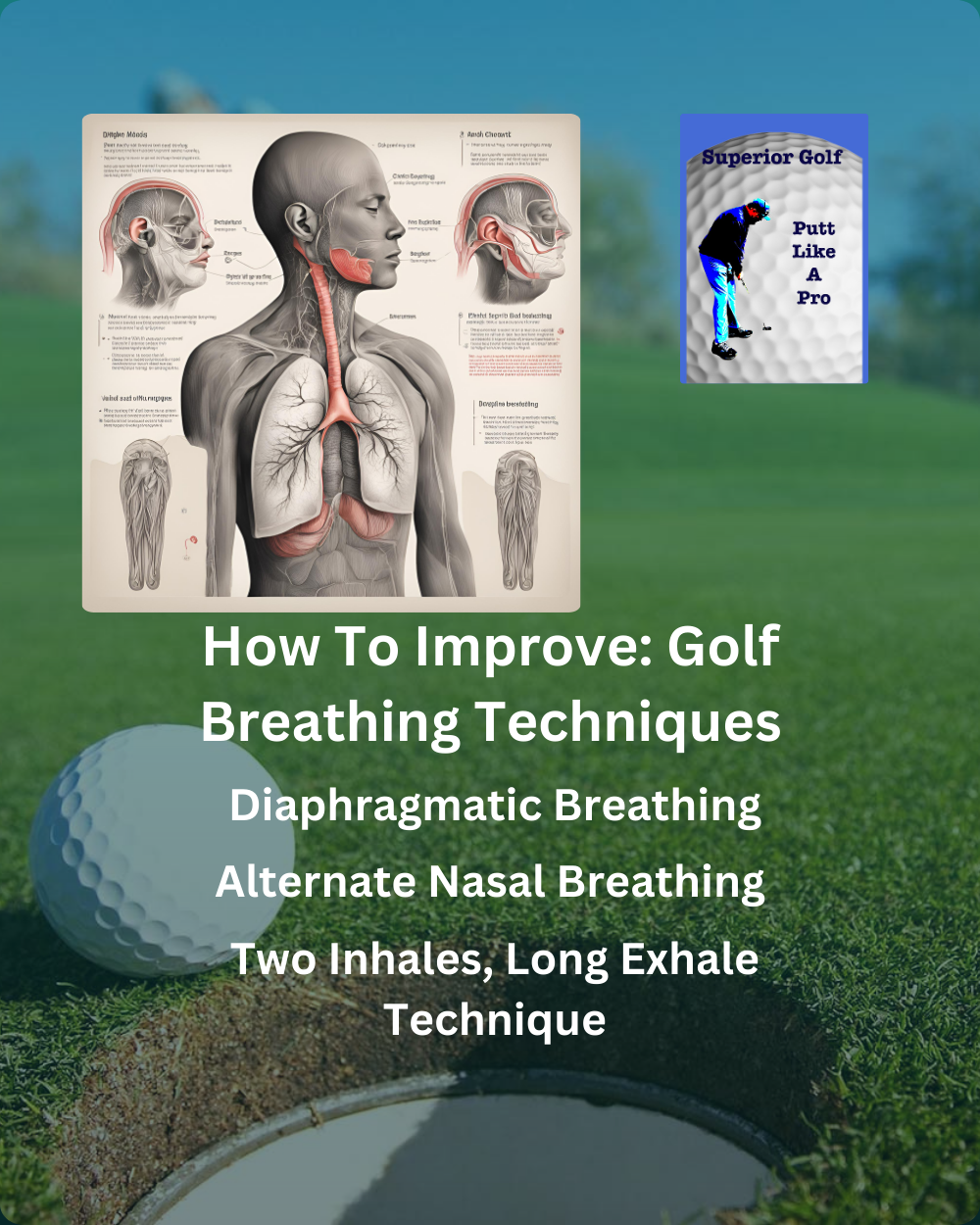Golf Breathing Techniques: Imagine you’re on the edge of the green. You feel the moment’s weight but find peace in breathing. This simple rhythm keeps you grounded and boosts your performance. Breathing is a vital, yet often missed, part of golf. It can greatly improve your swing and your overall game.
Think of top athletes who use breathing to get ahead. Focusing on breath control can up your golf game and fitness. For example, New Zealand’s Josh Geary shows how the right breathing patterns can improve your swing and keep you calm, even with the stress of travel and competitions. Good breathing, controlled by our nervous system, is key for managing your heart rate and stress. This helps a lot in learning golf breathing techniques1.
Stress can cause shallow breathing. This makes blood vessels tight, raises blood pressure, and messes with your thinking1. But, using the right breathing methods can lessen these effects. It helps control your muscles better and boosts your game1. With practice, you can greatly lower anxiety, confusion, and tight muscles1. Staying aware and practicing regularly can really help any golfer improve1. It’s not just about physical practice but also building mental strength and learning how to breathe correctly.
Key Takeaways
- Breathing exercises are great for dealing with depression, anxiety, and muscle tightness1.
- Shallow breathing can mess up your thinking and memory, impacting your golf negatively1.
- Proper abdominal breathing uses your diaphragm and is key for great golf swings1.
- The autonomic nervous system plays a big role in managing your heart rate and stress in golf1.
- Regular breathing practice can significantly help with both the physical and mental parts of the game1.
Understanding the Importance of Breathing in Golf
The way we breathe in golf is key to playing better. It affects your heart rhythm, muscle actions, and even your mood. By focusing on your breathing and doing golf exercises, you can greatly improve. This covers both the physical and mental parts of golf.
The Science Behind Breathing
Studies have found that using your diaphragm for 70% of your breaths is best for golf2. Training your diaphragm for 6-12 weeks can make it stronger2. Diaphragmatic breathing helps increase your lung space and can even make your golf swing better3. Experts suggest practicing these breathing methods for 10 minutes, two times a day, for six weeks to see real changes2.
Impact of Breathing on Physical Performance
Controlled breathing does more than just improve your body’s workings; it also enhances how you play. Focusing on your breathing while practicing can lead to smoother, more relaxed swings3. Taking deep breaths as you walk to the next hole helps refresh your mind and body3. Also, 12 golfers noticed their clubhead speed went up after using Alternate Nasal Breathing (ANB)4. Meanwhile, 13 golfers saw increases in how fast and far their balls went4.
| Breathing Technique | Observed Benefits |
|---|---|
| Diaphragmatic Breathing | 70% optimal performance, muscle strength improvement |
| Alternate Nasal Breathing (ANB) | 8.5 bpm reduction in pulse rate, 5.8 yards increase in distance |
| Bounceback 10 Technique | Smoother swings, less tension |
Emotional and Mental Benefits
Golf isn’t just about the physical skills. It also requires mental strength. How you feel can change how you breathe and play2. Pros focus on breathing right between shots to keep stress low and stay calm2. The “Bounceback 10” breathing method is great especially after a bad shot3. It involves a slow inhale through the nose and a longer exhale. This steady breathing helps you stay calm, move smoothly, and handle stress better.
In summary, mastering breathing techniques can give golfers an edge. It connects your breathing with your nervous system, helping you deal with the sport’s demands. By learning how to control your breath, you can face golf’s challenges with confidence and calm.
Golf Breathing Techniques
Getting better at golf can depend a lot on how you breathe. Learning the right breathing techniques can help your mind stay calm and your body perform well. Let’s look into how deep breathing and certain exercises can improve your game.
Deep Abdominal Breathing
Deep abdominal breathing is all about using your diaphragm when you breathe. This technique helps you get more oxygen and supports your core. This is really important for a good golf swing. Experts say that the diaphragm is behind 70% of our breathing. It’s a muscle we can strengthen with practice2. Stronger breathing means a stronger and more controlled swing. Research shows top golfers use these breathing tricks to stay cool and focused, showing how effective it is2.
Practical Exercises to Enhance Your Breathing
Adding breathing exercises to your training is key for better golf. Studies show practicing breathing for 10 minutes twice a day for 6 to 12 weeks makes a big difference2. One good exercise is to take two quick breaths through the nose and then a slow breath out through the mouth. This was suggested by Lewis Howes. It’s great for your circulation and stress level, helping you keep your focus and accuracy during your swing. These techniques not only help your body but also make you mentally and emotionally stronger, crucial for great golf.
| Type of Breathing | Benefits | Recommended Duration |
|---|---|---|
| Deep Abdominal Breathing | Improves oxygen uptake, enhances core stability | 6-12 weeks, 10 minutes twice daily |
| Two Inhales, Long Exhale Technique | Balances circulation, reduces stress | Before and during rounds |
By doing these breathing exercises every day, you can really improve your swing and fitness. Focusing on your breathing helps your mind and body get ready for better performance. Every time you play, you’re getting closer to mastering your breath for the game.
Conclusion
To really shine in golfing excellence, we must understand how golf breathing strategies play a huge role. It’s not all about having strong muscles. You also need a steady mind and good technique. By working on better breathing, you can keep calm and perform better on the course5.
Using techniques like Resonance Frequency Breathing (RFB) can really help your body’s systems work better together. This can lead to a calm heart and steady blood pressure, making it easier to play your best. This has been shown by tools like NeuroPeak Pro and Kardia apps5. Regular practice can make all golfers, whether beginners or pros, see big improvements6.
Trying out these breathing exercises can also help with everyday stress, not just golfing worries. Techniques like deep belly breathing and counting your breaths can sharpen your focus and make you feel better6. With a little bit of practice, you’ll find yourself more calm and focused, whether you’re playing golf or just going about your day6.
So, putting effort into golf breathing strategies and building mental strength is key for top-notch golfing. This hard work on your breathing can pay off big time. You’ll see better swings, feel more stable, and be emotionally stronger. These are all must-haves for staying ahead in the highly competitive world of golf.
FAQ
How can breathing techniques improve my golf game?
What is deep abdominal breathing?
What are some practical exercises to enhance my breathing for golf?
How does breathing affect my emotional and mental state during a game?
Can breathing techniques help with golf fitness?
Why is diaphragmatic breathing important for swing mechanics?
How can I integrate breathing exercises into my golf routine?
Are there specific breathing techniques recommended for golfers by professionals?
Source Links
- https://www.golfpsych.com/breathing-for-better-golf/
- https://www.thebreatheffect.com/golf-breathing-exercises/
- https://golfstateofmind.com/breathe-yourself-into-ready-mode/
- https://collegeofgolf.keiseruniversity.edu/theimportanceofbreathingingolf/
- https://igp.golf/article/ultimate-guide-to-on-course-breathing
- https://antiflipstick.com/the-role-of-breathing-techniques-in-golf-keeping-anxiety-in-check/

